Tuesday, December 31, 2013
Josh Ferrin always wondered what he would do if he suddenly struck it rich - then he found out in the ultimate test of his character.
Josh Ferrin's hands trembled as he fumbled for the phone. He started pacing the floor. He was so giddy from joy that when his wife answered, he choked on his first words.
"Tara," he blurted, "you're never going to believe this... "
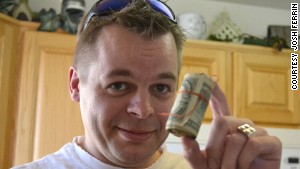
Finding $45,000 in his new home changed Josh Ferrin's life, but not the way he first imagined.
Ferrin had just discovered $45,000 stashed in his new home.
There's a biblical parable about a man who found treasure hidden in a field. Ferrin found his in a dusty attic. For years, the author and illustrator had wondered what would happen if he struck it big. Would sudden wealth change him?
Three years ago, Ferrin got his answer.
His story began one Wednesday in May, when Ferrin was miserable. He was suffering from pneumonia and had been forced to take time off from his job as an artist at the Deseret News in Salt Lake City. But things were looking up. He and his wife had just closed on their first house, and Ferrin decided to take a private tour after getting the keys.
Ferrin moseyed back to the garage, where he noticed something odd: a scrap of carpet dangling from an opening in the ceiling. Grabbing a ladder, Ferrin tugged on the carpet and pulled back a celling panel leading to an attic.
When he climbed into the attic, Ferrin saw eight World War II-era ammunition boxes. He delicately pried one open, dreading seeing a grenade. Instead what he saw blew his mind: wads of bills held together by orange fishing twine. He started counting -- and kept counting until he eventually realized he had stumbled onto $45,000.
He called his wife, already envisioning how they could use the cash: remodel their new house, repair their car, maybe even adopt. But her first response chilled those plans. She told him to call the family who previously owned the house.
"I immediately knew she was right," Ferrin said. "As much as I wanted to keep it, I couldn't keep it. That just wouldn't be right."
The previous owner was Arnold Bangerter, a biologist with the Utah fish and wildlife department and a father of six. His wife had died in 2005, and after Bangerter died in 2010 his children sold the house to the Ferrins. It turned out Bangerter had been squirreling away money for years; some of the bills dated back to the 1970s.
Ferrin contacted Bangerter's children and gave them all the money.
Before he did, though, he had a little fun. He photographed his two boys, Lincoln, 10, and Oliver, 7, throwing piles of cash up in the air while he yelled it was raining money.
Not everyone thought it was a laughing matter to give back so much cash. Some people told Ferrin he should have kept the money, that he had a legal right to it because he found it in his home. For Ferrin, something could be legal, but that didn't make it ethical. How could he keep money intended for someone else?
"We always wonder to ourselves, if I struck it big would it change me?" he said. "Would I be a different person? It was hard to hand over ($45,000), but it was the right thing to do."
What sealed Farrin's decision, though, wasn't ethics; it was fatherhood. Ferrin thought about the devotion Bangerter had for his children, and he saw a kindred spirit.
"I imagined this guy, for years and years, collecting money and putting it away. I understand that need to think for the future and take care of loved ones. I can understand him as a dad."
I didn't want to be the guy who found something and kept something secretly.
-- Josh Ferrin
-- Josh Ferrin
Ferrin said he, too, is trying to leave something for his children as they grow up.
"There's a big world out there and I try to teach them to be good young men," he said. "Sometimes I come short of that. They'll forget about all the lectures I gave them. But I think they will remember this one."
Ferrin left the Deseret News but is still an artist. He draws political caricatures and whimsical children's illustrations and has written a book, "Blitz Kids," about his grandfather's role with the University of Utah's improbable basketball championship team in 1944.
Ferrin's art and his book, however, are not just a means to earn a living.
"It's my attempt to establish a legacy that will last beyond me," Ferrin said.
Now Ferrin's deed is part of that legacy.
News of his selfless act spread across the globe. His story is preserved online. He has received letters from around the world. One guy in Australia said he would be honored to buy him a beer. Another person sent him a pocket knife with the engraving, "Honesty has its own rewards." Ferrin had to stop granting interviews after a while because it became too much.
He says today that what he gained from giving away his treasure is more than what he found.
"It was one of those moments that test your character," Ferrin said. "We are the sum total of our decisions. I didn't want to be the guy who found something and kept something secretly. I don't regret it at all. It made me a better person."
-- John Blake, CNN
Priest buys painting for $660 and asks ‘Antiques Roadshow’ to appraise it for him finds out is an original Anthony van Dyck masterpiece worth $661,000!
The BBC One program Antiques Roadshow has discovered a “lost masterpiece” by 17th Century master Anthony van Dyck.
A priest in Nottingham, Father Jaime, had purchased the painting for $660, and brought it to a filming of Antiques Roadshow to be professionally appraised. Host Fiona Bruce initially thought the painting a fake, but something about it caught her eye.
She had just “spent weeks looking at nothing but Van Dyck paintings” with art expert Philip Mould, and suspected it might be genuine, so she called him in and he believed it was worth investigating.
After months of careful restoration, the pair consulted Van Dyck expert Christopher Brown, who verified it as a genuine Van Dyck worth approximately $661,000.
“Discoveries of this type are exceptionally rare,” Mould said. “The painting’s emergence from beneath layers of paint was dramatic. It’s been revealed as a thrilling example of Van Dyck’s skills of direct observation that made him so great a portrait painter.”
“It’s everyone’s dream to spot a hidden masterpiece, I’m thrilled that my hunch paid off, to discover a genuine Van Dyck is incredibly exciting,” said Bruce. “I’m so pleased for Father Jamie.”
It is the most valuable painting ever discovered by the program in its 36 years on air.
Brotherly love on the slopes in Colorado as Davis LeMair rescues his older brother Edwin...
When a day of Colorado skiing last week turned perilous due to an avalanche, Edwin LaMair had his younger brother to thank for pulling him out of a potentially life-threatening situation.
Edwin, 22, and Davis LeMair, 19, were skiing with friend Jack Edgar on a backcountry trail in Vail on Dec. 22 when an avalanche engulfed Edwin, burying him up to his head. After a few minutes of reduced visibility following the slide, Davis was able to spot his brother and quickly skied over to help him.
He found Edwin almost completely submerged under the snow and struggling to breathe, which was all captured on a GoPro camera mounted on Davis’s helmet.
“I was really worried I was going to be buried completely,’’ Edwin said during the taped segment on TODAY Monday. “I’m extremely thankful that everything turned out the way it did and that I didn’t sustain any worse injuries or die.”
Edwin escaped with only a knee injury, and will have surgery later this week to repair a torn ACL and MCL that will keep him out of action on the slopes until the next ski season. He also was lucky because the avalanche occurred close to 4 p.m., so there was enough daylight left for Davis to be able to spot him.
“We were lucky that they were able to find me and my head was above before it got dark, because if they had to search for me in the dark, it could’ve been a bad situation,’’ Edwin told guest TODAY anchor Bryant Gumbel.

TODAY
Edwin LaMair was buried up to his head in snow.
The brothers and friend Jack Edgar are certified in avalanche safety and were carrying avalanche probes, beacons, shovels and other gear. They also had AvaLungs, which allow users to breathe for 30 minutes while trapped under snow, but the force of the avalanche ripped it out of Edwin’s mouth before he could apply it.
“I saw the snow cracking up and starting to slide downhill below me as I was making a right turn, and then I kind of fell head first downhill, and that’s when I really realized I was in an avalanche,’’ Edwin said. “I was worried when I couldn’t get the mouthpiece for the breathing device back in my mouth, and I inhaled some snow, so I felt like I was choking or wasn’t able to breathe. It kind of shot me to the surface, and I was swimming frantically through the snow.”
“I was maybe 100 yards on top of a cliff band, and I could see him sliding down to my right,’’ Davis said on TODAY. “At first I just heard like a wind gust, and it put me on alert. Then I looked over and I couldn’t see anything because it was just white on white. Then I started to see debris flow down, and then Edwin slid down at the end of the avalanche.”
The brothers had checked with the avalanche center before they went up on the mountain and said the forecast for a potential avalanche was a 2 on a scale of 5. They also tested their avalanche beacons before making the run.
“We never really thought that run would slide,’’ Davis said. “We had skied it earlier in the day, so I guess it just teaches us that you never know and be a lot more cautious now.”
“I’ll have his back any time we’re doing any backcountry activity or anything in the mountains, and I’ll always be looking out for him just like he did for me,’’ Edwin said.
Monday, December 30, 2013
Christmas Eve was very special for homeless couple Chris Derrick and Betty Ybarra as they moved into their new home...
For many couples, the thought of living together in a 96-square-foot house sounds awful. But for Chris Derrick and Betty Ybarra, it’s a Christmas miracle.
That’s because Derrick and Ybarra have spent the better part of a year braving Madison, Wisconsin’s often-harsh climate without a roof over their head.
They’ll spend this Christmas in their own home, thanks to more than 50 volunteers with Occupy Madison, a local Wisconsin version of the original Occupy Wall Street group in New York. The group, including Derrick and Ybarra, spent the past year on an innovative and audacious plan to fight inequality in the state’s capital: build tiny homes for the homeless.
In a city where an average home for sale costs nearly $300,000, many low-income individuals simply can’t afford somewhere to live.
Indeed, in January of this year, a citywide count found 831 homeless people living in Madison, a 47 percent increase in the past 3 years. And it’s not just adults; 110 families with children were identified as well.
The “Tiny House Project” began the same month. The plan was for volunteers to build micro-homes that still include living necessities like a bed, insulation, and a toilet. The homes are heated via propane and include a pole-mounted solar panel to power the house’s light. The total cost: $3,000, paid for by private donations.
Rather than building the homes on a particular lot of land — and thus adding another expense — the houses are mounted on trailers which can be legally parked on the street, as long as they’re moved every 48 hours. Parking on the street may not even be necessary after Occupy organizers successfully convinced the Madison Common Council recently to change the city’s zoning laws so the homes could be parked on private property with permission.
As Occupy Madison continues to build more tiny houses, it hopes to eventually buy a plot of land and create a tiny village with as many as 30 homes.
“It’s not just a shelter, it’s a commitment to a lifestyle,” Brenda Konkel, who heads a tenants’ rights non-profit in Madison, said during the zoning meeting, according to The Capital Times. “It’s a co-op mixed with Habitat for Humanity mixed with eco-village as the long-term goal.”
On Tuesday, Christmas Eve, Ybarra and Derrick moved into their new home. Ybarra said the moment was “exciting,” telling NBC 15 that she’d never owned her own home before, much less one she helped build. Occupy Madison posted this video to mark the occasion.
Though a common critique of the Occupy movement was that its goals were nebulous and unspecific, it has effected a significant amount of change on a local level. This includes savingmany people’s homes from foreclosure and buying up (and then forgiving) $15 million of consumer debt for pennies on the dollar.
Oklahoma woman Teriasia Dean finds out what goes around comes around after returning $800 that she found...
OKLAHOMA - New details on a story that caused dozens of NewsChannel4 viewers to call asking how they can help.
Teriasia Dean found a purse on the pavement, and despite facing eviction and her own financial woes, she returned the purse to the owner.
Doing the right thing was easy for Dean, but it touched so many viewers, they wanted to help her with her rent.
News Channel Four caught up with Dean on Christmas. She was laughing with loved ones, but in the back of her mind, she carried the rent burden.
“I’ve always been that, never let them see you seat type girl,” said Dean. “I tough it out, and I make it work.”
She’s been working her retail make up job to catch up on her rent for months.
She’s been battling staph infection, and fell behind on the payment.
She’s been battling staph infection, and fell behind on the payment.
Then, she the apartment complex posted an eviction notice on her door. She has to pay $670 by Friday or get out.
All the while, Dean held the key to dealing with the eviction.
She found the Coach purse in a parking lot.
She found the Coach purse in a parking lot.
Instead of stealing money from the wallet, she returned it to the rightful owner: Barbara Cannon.
“I’ve gone through my own life experiences where I had to step back, and I had to humble myself and know that material things and money don’t make me. So, t wouldn’t have made me to spend her money or swipe her card,” said Dean.
A decision so touching, viewers are calling and e-mailing to see if they can help Dean with her rent realities.
Dean’s grandmother says she understands why.
“It’s a rude awakening that there are some honest people in the world,” said Helen Potter. “They’re still out there doing good-by people.”
One viewer, whose identity we promised not to reveal, showed up with her hard-earned cash all for Dean.
Tears filled Dean’s eyes. “Oh wow. $800 dollars. Oh wow!” said Dean. “You have people who don’t even know you who do things for you and bless you, and I’ve always been a giver, and it’s different to receive, you know?”
Counting the money, she sent this message to the mystery donor: “Thank you so much. Thank you so much for, if it was placed on your heart and following through. I am forever grateful. I am very thankful.”
Sunday, December 29, 2013
Homeless mom Crystabel gets the surprise gift of a lifetime from complete strangers...
Say you arrive one day for an important job interview, but find there's no job, no interviewer and no office. Instead, as soon as you open the door, you find festive balloons and 20 people in an apartment shouting to you, "Welcome to your new home!" The 20 include camera crews and reporters from three news stations covering the story, the apartment owner who's donated the apartment rent-free for six months, a couple who provided the food, professional chefs who've prepared a gourmet meal for you, a bottled lemonade company providing the drinks, and a professional singer there to entertain you.
It sounds like a terrifically enjoyable dream or Hollywood movie fantasy, but it really happened exactly that way in a residential neighborhood in Hollywood, at ten in the morning on December 21, the first day of winter, to a twenty-something Hispanic woman named Crystabel, who prefers not using her last name since her daughters are in foster care. A crystal ball is used by psychics to see into the future. But surely Crystabel could never have predicted this day. Nor when she was younger could she have predicted all she's endured the last couple of years, from becoming homeless, to losing her job, then losing her children, to living out of a borrowed truck as she attempted to eke out an existence selling things on eBay.
It was at this lowest point for Crystabel that she was brought to the attention of independent news producer Mytchell Mora. From 1998 to 2010, Mora produced over 165 news stories for Fox News' Undercover Unit. Mora's investigative stories have led to the arrests of a sexual predator, a murderer and doctor whose negligence led to patient deaths. And now, Mora wanted to help. He contacted Kameron Segal, president of William Holdings, Inc., a Los Angeles property management and acquisitions company. Segal agreed to allow Crystabel to live in one of his $1,200-per-month East Hollywood apartments, rent-free, for six months. The apartment includes a refrigerator, full bathroom, secured intercom entry phone system, and laundry facilities inside the building.
Mora contacted others, who agreed to help in other ways. Ira Mandel, president of Fortress Jets, donated the food, furnishings and bath items. His wife, Jenny, and their two young daughters, showed up to help get things in order. Chef Pieps of Naked Catering and Chef D' of Soul D'licious, provided the mouth-watering brunch, and Hubert's Lemonade donated the drinks. A professional singer regaled the gathering with a heartfelt rendition of the classic, "Have Yourself a Merry Little Christmas."
Mora arranged to escort Crystabel to the location for her "job interview" at 10 a.m. As she walked in and was immediately greeted by the room full of people, the media, balloons, fragrant cooking aromas, and the shouts of "Welcome to your new home!", it was clear that Crystabel was genuinely surprised--and moved. Mora let her know that the apartment was now hers. She was overwhelmed, as were all witnessing the scene.
For those wishing to help Crystabel and her children further with any donations or job offerings, please email her here. She has a degree from Pasadena City College and is experienced in payroll/accounting and accounts payable work.
Crystabel is just one person and helping her amounted to a drop in the bucket when you consider the multitude of needy people in Los Angeles. Yet what better demonstration of the holiday spirit of giving and caring, of offering hope? It brings to mind the quote often attributed to Dr. Seuss: "To the world you may be one person, but to one person you may be the world."
15 year old cancer patient Karina Xavier gets a surprise visit from super model Gisele Bundchen...
MALDEN (CBS) – A 15-year-old girl battling cancer is posting photos of a surprise visit she received on Thursday from Gisele Bundchen.
Karina Xavier, who was born in Brazil and lives in Malden, spent some time today with Bundchen. Xavier, who is a fashion blogger, posted pictures of herself doing Bundchen’s make-up, along with photos of the two hanging out together.
“Thank you so much for taking time off of your day to come visit me and spend some time with me! Also thank you for your kind words and your very meaningful gifts! You are a great person and you will continue inspiring me,” Xavier wrote on Instagram.
Bundchen also posted a photo.
“It was a pleasure to see you again @chicbykarina. You are warrior, an inspiration of positivity and courage. I will be praying for you. Sending you love and light always,” she wrote.
New York landscaper Marvin Rosales Martinez finally gets to collect his million-dollar lottery prize a year after finding ticket while raking leaves...
New York (CNN) -- In the post-Superstorm Sandy destruction, New York landscaper Marvin Rosales Martinez was clearing storm debris with a leaf blower when he discovered an unknown treasure hidden in a pile of leaves.
The damp "Win $1,000 a Week for Life" scratch-off ticket could change his life.
Rosales Martinez, 27, a resident of Hicksville on Long Island, was awarded his $1 million lottery prize on Friday, more than a year after he claimed the winning ticket. He found the ticket among leaves in October 2012.
According to a New York Lottery statement, Rosales Martinez first brought the ticket to a 7-Eleven, but the store couldn't verify it.
It wasn't until November 9, 2012, when Rosales Martinez brought the ticket to the lottery's Long Island Customer Service Center that officials confirmed that it was a winning ticket.
Then, there was a "standard and thorough internal security investigation" to ensure the validity and ownership of the ticket.
According to Lee Park, a lottery spokesman, the review found no reason to believe that the ticket "wasn't rightfully the property of Mr. Martinez. There was no report of theft or of a ticket being misplaced."
"It should be noted that Lottery tickets are bearer instruments," said Park, referring to instruments that may be converted to cash by whomever holds it. "In instances such as these, it's standard practice for the lottery to require a one-year waiting period before awarding the prize in case anyone else comes forward."
In this case, no one stepped forward.
Rosales Martinez was one of five New York lottery winners to claim a prize Friday.
The recipient opted to receive his jackpot prize as a one-time lump sum payment. He will receive a payment of $779,106, netting him $515,612 after required tax withholdings, according to the release.
Rosales Martinez, who could not be reached for comment, told lottery officials that he planned to share his good fortune with his family.
Saturday, December 28, 2013
Formerly Homeless Veterans in Boston helping to keep others off the streets...
CONCORD, Mass. -- Not far from where the Boston Massacre helped sow the seeds for the Revolutionary War, David Dyer points toward the underpass where he'd score crack cocaine by day and the train depot where he'd sleep some nights.
Now, he has a family, a home and a job -- helping homeless veterans get off the streets, like he did.
Dyer is part of a team of veterans, some formerly homeless themselves, that the state of Massachusetts has hired to get veterans off the streets in the Boston area. Typically, they spend one day a week roaming the city's storefronts, alleys and shelters, which is what he was doing one recent morning outside Boston's South Station. "I guess you could call this my home for about a month," he reminisced.
The rest of the week is spent making sure those who have found housing are staying the course. The Veterans Affairs Department, which funds the effort, is considering doubling the size of the team in the coming year.
President Barack Obama's administration has pledged to eliminate homelessness among veterans by the end of 2015. And while the rate has been dropping, time is running short.
So communities such as Boston are aggressively hitting the streets with offers of housing, treatment and hope. Using formerly homeless veterans such as Dyer and team leader Christopher Doyle helps them make inroads with a community that often is distrustful of people who haven't experienced what they've been through.
"When they say, 'Oh, you don't know what I'm talking about,' I can say, 'Yeah, I do, because I was there myself,'" said Doyle, who at one point lived in a VA homeless shelter with about 180 other veterans before landing a job with the state.
A home of his own
James Harrington appears to be one of the program's success stories.
Harrington estimates that he was homeless for nearly a dozen years. At first, he said, he lived in vacant apartment complexes that were under construction. Then he spent most of his nights at Logan International Airport.
He arrived at his new one-bedroom apartment in February with nothing but his door keys and a backpack.
It took him about a month to get used to the feeling that he could stay -- if he wanted to.
"You're so used to living so many years in someone else's domain," said Harrington, 66, an Army veteran who served stateside during the Vietnam War. "There was this expectation that someone's going to be coming through the door because they really own the place that you're in."
Harrington takes great pride in turning his new apartment into a home. He found a couple of Ethan Allan end tables that neighbors were going to throw away. Carly Brown, a VA social worker, drove him to a local furniture bank where he picked out a sofa and a bed. And Doyle chipped in as well, giving him an RCA television. Now just look at the place, Harrington beams.
"Where are you going to find something better than this?" said Harrington. "You're not."
A voucher from the federal government pays $981 of the veteran's monthly rent. He uses his Social Security and a VA pension to pay another $221 himself.
Doyle checks on him weekly to make sure he's OK. "I sometimes just talk to him about the last movie he watched," Doyle said. "It's to show I have an interest in his life."
Doyle said he believes that regular visits from a fellow veteran make it harder for his clients to give up and go back to their old life.
"It's easy to put someone into an apartment, but it's not as easy to keep them in one," Doyle said. "A lot of these guys do have mental health issues or substances abuse issues. Sometimes, that's the reason they do the right thing because they know I'm going to come see them."

The federal government estimates that there are roughly 58,000 homeless vets. Veterans contribute a significant amount of support to homeless outreach teams in communities such as Los Angeles.
Reaching homeless vets
The federal government estimates that the homeless rate among veterans has dropped by about 25 percent in the past three years, but nearly 58,000 veterans remain on the streets or in temporary shelters on any given night.
"I have said from the beginning, the climb will get steeper the closer we get to the summit," Veterans Affairs Secretary Eric Shinseki said earlier this year in Washington. "All the easy cases will have been housed. In the end, we will have the toughest, most difficult cases to solve -- some prior failures, some behavioral problems, even some serious mental health issues."
VA officials point to Boston as a model for what can be done when local and federal organizations work together. Their focus is to get chronically homeless veterans into a house or apartment as soon as possible instead of putting them into temporary or emergency shelters for months at a time. Then, once the vet gets into a house, officials arrange the support services the veteran will need to stay there, such as substance abuse counseling and job training. Typically, the federal government pays most of the cost for the home through a voucher. Local officials and nonprofits also help coordinate the support services that are, again, mostly paid for through the VA.
"When you put housing as the priority, the treatment and everything else comes along in a much more effective way because they're getting their most basic needs met first," said Vincent Kane, director of the National Center on Homelessness Among Veterans, which conducts policy analysis and research. "They're not worried where their next meal is coming from or what roof will be over their head that night."
To estimate the number of homeless veterans, the federal government relies on an annual count that takes place in January. Thousands of volunteers, government employees and nonprofit workers search their local streets, parks and shelters in an effort to count the number of homeless people. The latest count in Boston estimated 458 homeless vets on any given night in 2013, a drop of 15 percent over the past three years. That's not as steep as the national drop, but VA officials in Massachusetts said that's partly because their outreach efforts have helped them find homeless people who previously would have gone uncounted.
Kane said veterans are key members of its homeless outreach teams in communities such as Philadelphia, Los Angeles, Detroit and Denver.
Healing power of lending a helping hand
Doyle and Dyer met each other at an Alcoholics Anonymous meeting. Doyle, who served in the Army during the first Gulf War, overheard Dyer speaking about his experiences in Afghanistan and decided to approach him and offer a friendly ear.
Dyer had drug problems before he entered the Army. After his discharge, Dyer said, his drug use intensified.
"It's just so much easier to use, you think, because you've totally given up on yourself," he said. "You've given up on life. You're pretty much pissed that you woke up."
His health went downhill and he eventually was hospitalized with kidney failure. He woke up to find his father sitting next to his bed. Dyer said he saw how badly he was hurting his family and resolved that his spiral was over.
Doyle, meanwhile, kept tabs on Dyer's progress and eventually asked him to join the veterans' homeless team. Dyer said the job helps him stick with his recovery.
"If you're not out there helping somebody, the chances of staying in recovery and staying clean, really, aren't that good," he said. "I found that out personally."
'I'm on vacation'
Most of the team's clients have drug and alcohol issues that require counseling and treatment. Harrington said he's never had a problem with drugs or alcohol and said his problems were financial. He said in recent years he spent most of his nights at the airport. At dawn, he'd head over to the Boston Public Library.
One night, an airport worker brought in a social worker from the VA to talk to him. The VA helped him get a pension to supplement his Social Security. It also helped him land a government voucher. He marveled at the support he's received.
"They had a whole team of support people, like, if you need furniture, they get you furniture. If you need food, they'll bring food to you," Harrington said.
But other cases are much tougher -- the chronic homeless that Shinseki referred to.
At Boston's Emmanuel Church, Bryant Draycott says he's been told he is No. 5 on the list to get a government voucher that would let him live in an apartment. The Navy veteran said he'll take help, but only on his terms.
"I'm the vet. They're not," he said. "You want to give me a room? You want to give me an apartment? OK, I'll stay there for at least a couple of days. I'll give it a try for a week. If I don't like it, I'll tell you what you can do with it."
And another thing, don't use the word homeless in his presence.
"To me, personally, I hate that word. I refuse to use the term homeless. With me, I'm on vacation."
Draycott estimates that he's been on vacation for about eight years.
"And loving every minute of it," he said.
Opening up to acceptance
Then there's Thomas Moore, 79, who has no interest in getting a government-subsidized apartment. He said he was willing to accept a blanket from the social workers who visit him, but when they broach the idea of housing, "I try in a kind way to back off."
He demonstrates just how difficult it will be for the Obama administration to reach its goal, despite all the assurances that it's on track. Sitting on the sidewalk a block from Boston's most luxurious shopping boutiques, Moore described having a "nervous breakdown" as a 17-year-old serving on the front lines in Korea. He said he feels responsible for the death of his best friend during one firefight and spent months afterward at Walter Reed Army Medical Center in Washington. He said he underwent numerous shock treatments.
When he gets tired of living on the street, he said, he'll rent a cheap hotel room for a month.
"There's something about the rough edge of living out here that distracts me from my inner life," Moore said.
Despite Moore's insistence that he doesn't want their help, the veterans' homeless team doesn't plan to quit asking him if he's changed his mind.
"You don't know when it's going to be that day when somebody says I'm done living like this and accepts the help," Dyer said.
Donald and Dorothy Lutz celebrate 61 years of marriage in photo shoot inspired by the Disney movie "Up"
Lilit MarcusTODAY contributor
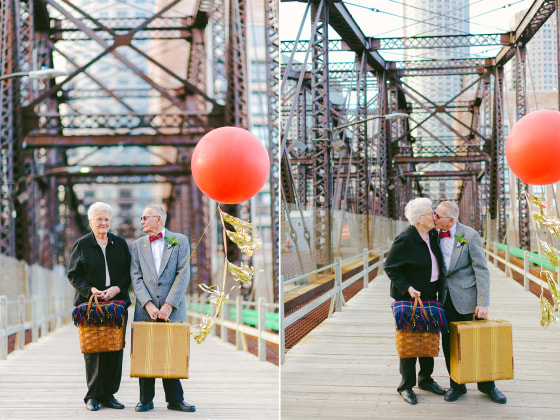
Cambria Grace Photography
Donald and Dorothy Lutz struck an 'Up'-inspired post for their anniversary photo shoot.
61 years ago, Donald and Dorothy Lutz's wedding photographer stood them up, leaving the lovebirds with only a single picture to remember their big day. But six decades later, they got a very special belated wedding gift — a beautiful anniversary photo shoot, inspired by the Disney movie "Up."
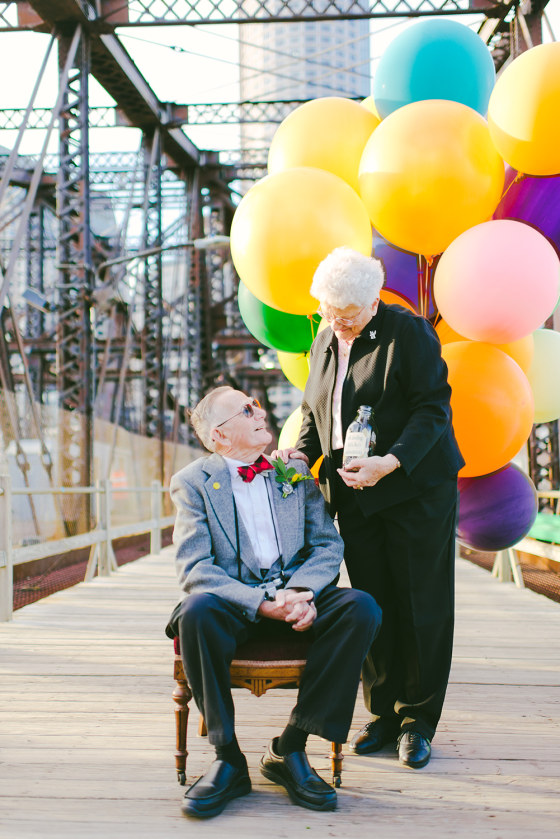
Cambria Grace Photography
The idea began when stylist Lauren Wells — who is married to the Lutzes’ grandson Matt — and her photographer partner Cambria Grace found themselves with a bunch of colorful balloons left over from a photo shoot. After a conversation with her husband, Lauren got the idea for the "Up"-inspired shoot and decided the photos would be a gift for her grandparents-in-law.
“It was actually a little bit of luck and coincidence,” Wells told TODAY.

Cambria Grace Photography
The shoot took place on Boston’s Old Northern Avenue Bridge, chosen for its “industrial” look, and was a true family affair, with Matt’s sister Abby assisting — and keeping pedestrians from crossing the bridge and walking through the shots.

Cambria Grace Photography
While "Nina and Grandpa" didn’t know how a photoshoot worked, Wells says they were more than game to participate, which didn't even take much work in the costume department: “He is always wearing a bowtie, so he didn’t even have to dress the part!”
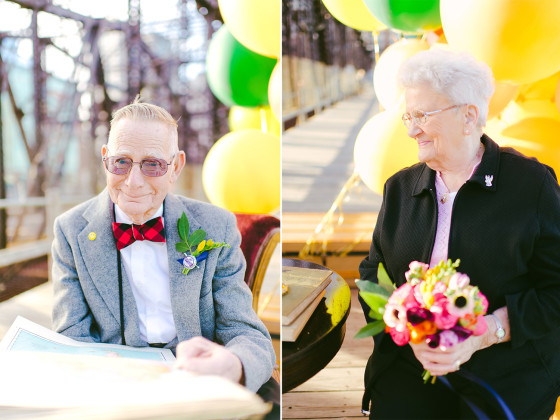
Cambria Grace Photography
There was just one problem: Neither grandparent had actually seen the movie. A relative screened the opening sequence for them so they could see the inspiration for the balloons, but passed on showing them any of the sadder scenes.

Cambria Grace Photography
“They were adorable and super into it,” Grace says of the Lutzes. “I asked how they met and he said that he was going off to war and he told her that if she wrote to him, he would write back. They became pen pals, then friends, and fell in love and have been together ever since.”
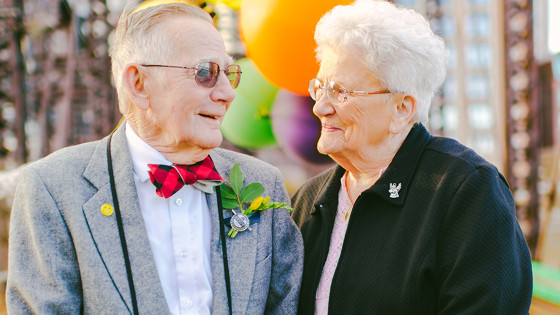
Cambria Grace Photography
Once the photos were finished, Wells posted them on the wedding website Style Me Pretty, where they started to go viral within hours as people shared the images far and wide on social media. Admirers wrote to Wells and Grace from as far away as China, Spain, and Australia — some even asking if they could arrange custom photo shoots for their own parents or grandparents.

Cambria Grace Photography
For the two friends and collaborators, the real treat was how many positive reactions the photos got. “The outpouring of well wishes have been so nice and heartwarming,” Wells says. “I read 100-something comments from all over the world and started crying. It doesn’t matter where you live, everyone loves love.”

Cambria Grace Photography
And the best reaction, of course, came from Grandpa and Nina themselves. A relative read the Style Me Pretty comments aloud to the couple, but they had to ask someone to print the pages out so they could send copies to friends who didn’t have computers. Inspired by that, Wells and her husband put the photos together into a beautifully bound scrapbook and presented it to the Lutzes on Christmas morning.

Cambria Grace Photography
Although it’s back to business as usual for Grace and Wells, who primarily do editorial photo shoots for brands and events, they know they might not ever get an assignment as special and meaningful as the one they did with the Lutzes.
“Nothing will ever be as good as this shoot,” says Grace. “Nothing can beat this.”
Beyonce Makes A Wish Come True as She Sings and Dances With a Terminally Ill Cancer Patient...
Dec 26, 2013 11:13am
Could we love Beyonce any more?
The megastar, who just released a secret album while touring and taking care of her daughter Blue Ivy, went out of her way to make the wish of a terminally ill cancer patient Taylon become a reality.
All Taylon wanted to do was dance with Beyonce, 32.
In a video posted by Bey, this Make-A-Wish girl gets to do just that.
Friends and family came with her to Las Vegas earlier this month to see Beyonce perform. As Beyonce hits the stage, the little girl is brought to tears.
Subscribe to:
Posts (Atom)








